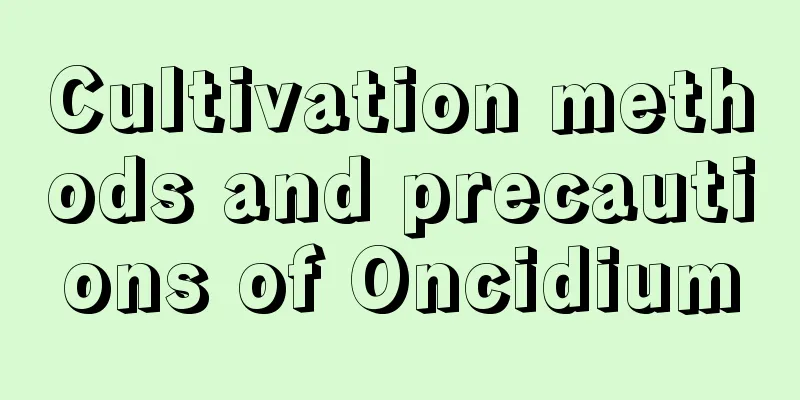Cultivation methods and precautions of Oncidium

Soil requirementsOncidium prefers a relatively dry environment. Before planting, lay a layer of broken tiles and bricks on the bottom of the flowerpot. It is best to choose soil with good drainage and air permeability. You can choose a mixture of 4 parts of broken fern roots, 1 part of peat soil, 2 parts of crushed charcoal, 2 parts of vermiculite, and 1 part of sphagnum moss. Light and temperature requirementsOncidium prefers a semi-shady environment and can be maintained under full sunlight in winter. It does not need shade, which can promote the flowering of the plant. In other seasons, shade should be provided to avoid leaf burns. Different varieties of Oncidium have different temperature requirements. The temperature of thick-leaf varieties cannot be lower than 12℃, and the most suitable growth temperature is 18~25℃; the most suitable growth temperature of thin-leaf varieties is 10~22℃, and the minimum temperature cannot be lower than 8℃. Water and fertilizer requirementsOncidium prefers a drier environment and can be watered when the soil surface is dry. During the growing season, you can increase the amount of watering appropriately, watering once in the morning and evening to ensure that there is no water accumulation. Reduce the amount and frequency of watering in winter, and control water to facilitate flowering. Stop watering when the temperature is below 10℃ to avoid frostbite. In spring and autumn, apply organic fertilizer every 20 days with a balanced amount of elements. You can either irrigate the roots or spray the leaves. Do not fertilize in winter when temperatures are too low. Precautions for Oncidium cultivationRepotting timeIt is usually time to repot Oncidium after it blooms, and the seedlings of Oncidium should be repotted before the growing season, such as in early spring or autumn when the weather is cool. When repotting, change to a larger pot or replace part of the soil depending on the growth of the plant. Watering methodIn summer, you need to pay attention to shade and cool down in time when the temperature is high. In midsummer, water the plant once a day and water it thoroughly, until water flows out from the bottom of the pot. Normally, water when the soil is half dry. |
<<: Breeding methods and precautions of Diaozhongliu
>>: Common varieties of Oncidium
Recommend
The difference between Prunus mume and Prunus armeniaca
1. Different plant heights Prunus armeniaca is a ...
Top Ten Famous Flowers in China
The King of Flowers - Peony The main ornamental p...
How to cultivate silver willow? Cultivation methods and precautions
Silver Willow Growing Conditions Silver willow pr...
How to care for water lilies bought from flower shops
1. Prune the roots After buying the water lily, y...
How long is the growing cycle of lentils?
Introduction to Lentil Growth Lentils are suitabl...
How many times a year can peppers be planted? How many months does it take to plant peppers?
How many seasons can peppers be grown in a year? ...
When is the best time to take cuttings of Tiger Pilan? What month is the best time to take cuttings?
Tiger Pilan cutting time The time for Sansevieria...
The breeding methods and precautions of Jihong Komatsu
The breeding method of Pinus jihongensis Cuttings...
What plants are suitable for the bathroom
1. Mint It will emit a fragrance, which is relati...
When to transplant winter jasmine
Forsythia, also known as yellow jasmine and golde...
Agarwood planting conditions and climatic conditions of the growing environment
Agarwood Planting Conditions Agarwood is usually ...
Lily cultivation methods and precautions
The maintenance of the fragrant lily is very easy...
How to grow lotus in water through the winter? Can lotus be grown in the north?
1. Wintering in the South In the south, the clima...
What's wrong with the old black stems of Schefflera arboricola hydroponic cuttings (the branches of Schefflera arboricola cuttings turn black)
Schefflera is evergreen all year round and is a v...
How to trim and shape the Yale Dance
1. How to prune Its pruning should be done in spr...









